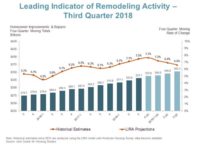Depending on the location of electronic home system contractors, there still may be challenges with remodeling business. A sluggish economy and housing market will continue to hamper home improvement spending well into next year, according to the Leading Indicator of Remodeling Activity (LIRA) by the Remodeling Futures Program at the Joint Center for Housing Studies of Harvard University, Cambridge, Mass. The remodeling market is expected to stay soft with the LIRA pointing to a modest decline in annual homeowner improvement spending over the next several quarters.
“After pulling through the worst of the downturn in home improvement spending, we appear to be entering another period of softening,” says Eric Belsky, managing director of the Joint Center. “The ups and downs in the economy are being reflected in home improvement activity.”
“Absent a more sustained upturn in the broader housing market, particularly in the sales of existing homes, there’s not much to propel growth in home improvement spending,” says Kermit Baker, director of the Remodeling Futures Program at the Joint Center. “Homeowners are continuing to undertake smaller jobs, but are still nervous about larger discretionary projects.”
The Remodeling Futures Program, initiated by the Joint Center for Housing Studies in 1995, is a comprehensive study of the factors influencing the growth and changing characteristics of housing renovation and repair activity in the United States. The program seeks to produce a better understanding of the home improvement industry and its relationship to the broader residential construction industry.
Past studies show that the most sure bet is for contractors to home in on home systems work at the multi-tenant and apartment levels.



